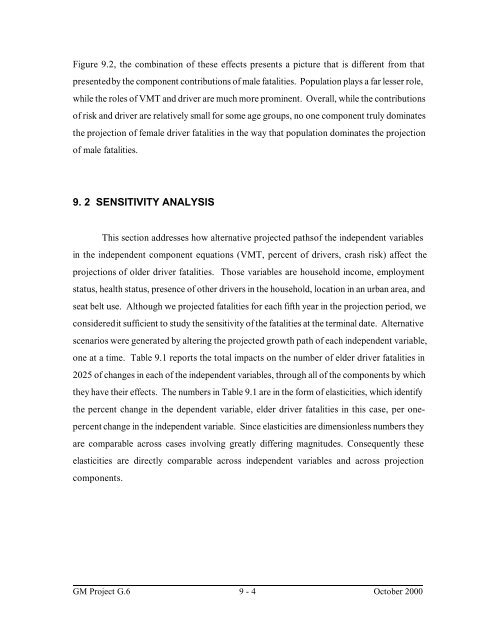Projecting Fatalities in Crashes Involving Older Drivers, 2000-2025
Projecting Fatalities in Crashes Involving Older Drivers, 2000-2025
Projecting Fatalities in Crashes Involving Older Drivers, 2000-2025
You also want an ePaper? Increase the reach of your titles
YUMPU automatically turns print PDFs into web optimized ePapers that Google loves.
Figure 9.2, the comb<strong>in</strong>ation of these effects presents a picture that is different from that<br />
presented by the component contributions of male fatalities. Population plays a far lesser role,<br />
while the roles of VMT and driver are much more prom<strong>in</strong>ent. Overall, while the contributions<br />
of risk and driver are relatively small for some age groups, no one component truly dom<strong>in</strong>ates<br />
the projection of female driver fatalities <strong>in</strong> the way that population dom<strong>in</strong>ates the projection<br />
of male fatalities.<br />
9. 2 SENSITIVITY ANALYSIS<br />
This section addresses how alternative projected paths of the <strong>in</strong>dependent variables<br />
<strong>in</strong> the <strong>in</strong>dependent component equations (VMT, percent of drivers, crash risk) affect the<br />
projections of older driver fatalities. Those variables are household <strong>in</strong>come, employment<br />
status, health status, presence of other drivers <strong>in</strong> the household, location <strong>in</strong> an urban area, and<br />
seat belt use. Although we projected fatalities for each fifth year <strong>in</strong> the projection period, we<br />
considered it sufficient to study the sensitivity of the fatalities at the term<strong>in</strong>al date. Alternative<br />
scenarios were generated by alter<strong>in</strong>g the projected growth path of each <strong>in</strong>dependent variable,<br />
one at a time. Table 9.1 reports the total impacts on the number of elder driver fatalities <strong>in</strong><br />
<strong>2025</strong> of changes <strong>in</strong> each of the <strong>in</strong>dependent variables, through all of the components by which<br />
they have their effects. The numbers <strong>in</strong> Table 9.1 are <strong>in</strong> the form of elasticities, which identify<br />
the percent change <strong>in</strong> the dependent variable, elder driver fatalities <strong>in</strong> this case, per one-<br />
percent change <strong>in</strong> the <strong>in</strong>dependent variable. S<strong>in</strong>ce elasticities are dimensionless numbers they<br />
are comparable across cases <strong>in</strong>volv<strong>in</strong>g greatly differ<strong>in</strong>g magnitudes. Consequently these<br />
elasticities are directly comparable across <strong>in</strong>dependent variables and across projection<br />
components.<br />
GM Project G.6 9 - 4<br />
October <strong>2000</strong>
















